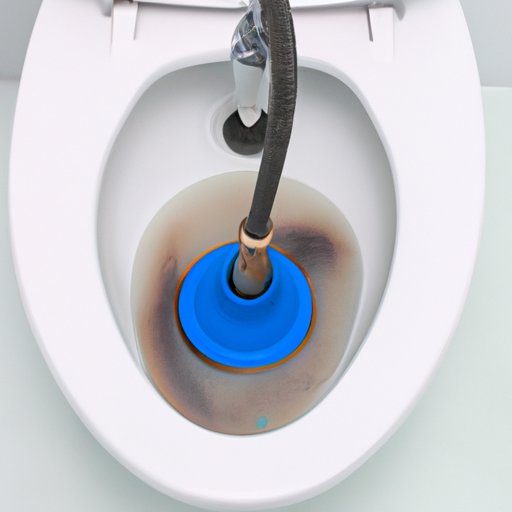I. Introduction
If you’ve ever encountered a clogged toilet, you know how frustrating and unpleasant it can be. Whether it’s caused by too much toilet paper or foreign objects that shouldn’t be flushed, a clogged toilet can quickly become a nuisance.
This article aims to provide you with a step-by-step guide on how to unclog your toilet when nothing else works. Whether you’re a homeowner or a renter, this guide is for you.
II. Use a Plunger
A plunger is a common household tool that can be used to unclog a toilet. It is available at most hardware stores and supermarkets. Plungers are designed to create a vacuum seal around the toilet’s drain hole, pushing and pulling water in and out of the hole to dislodge any clogs that may be present.
To use a plunger effectively, first ensure that the plunger’s rubber cup is tightly sealed around the toilet’s drain hole. Next, push down and then pull up the plunger’s handle to create suction. Repeat this motion several times until the water starts to drain.
Some plunging tips to bear in mind include:
- Use a plunger with a flange on the cup end as it forms a better seal
- Use a plunger with a long handle for better leverage
- Avoid flushing the toilet if one plunge isn’t sufficient
- Add water to the toilet bowl to enhance the suction
- Cover the rim of the plunger with petroleum jelly to improve suction
III. The Hot Water Trick
Hot water can break down or loosen clogs, making it an effective method for unclogging a toilet. When using this method, avoid extreme temperatures, as hot or boiling water can potentially damage do-it-yourself plumbing and cause burns.
To use hot water to unclog a toilet, fill a bucket with hot but not boiling water and pour it into the toilet bowl from waist level. Leave the hot water in the toilet for a few minutes, then flush the toilet. The hot water should break up the clog and allow the toilet to drain properly.
If the hot water doesn’t work, you can repeat the process several times or move on to another method.
IV. Use a Toilet Snake
A toilet snake is a flexible and coiled wire tool that can be used to reach and clear clogs that are too deep in the toilet drain for plungers to handle.
To use a toilet snake, first, wrap a towel around the toilet’s base to protect it from scratches. Insert the head of the snake into the toilet bowl and twist it to maneuver it around the drain hole. Push and pull the snake through the clog to dislodge it from the drain. Once you feel that the clog has been removed, flush the toilet to test the flow.
It’s important to note that a toilet snake can damage your toilet’s porcelain if not used correctly. Be sure to read the instructions and exercise caution.
V. Baking Soda and Vinegar
Baking soda and vinegar create a reaction that releases carbon dioxide gas, which can help to dislodge clogs. This natural solution is both safe and effective for removing clogs.
To use baking soda and vinegar, first measure one cup of baking soda and pour it into the toilet bowl. Next, pour two cups of vinegar over the baking soda and allow the mixture to sit for at least 30 minutes. Finally, flush the toilet to remove the clog.
If your toilet remains clogged after using this method, you can try the process again or move on to a different method.
VI. Use a Wet Vacuum
A wet vacuum is a powerful tool that can aid in the removal of stubborn clogs. You’ll need to use a specific wet vacuum designed for this purpose as regular vacuums are not designed for water handling.
To use a wet vac for this purpose, first fill the vacuum’s tank with enough water to cover the toilet’s suction hose. Next, insert the hose into the toilet bowl and turn on the vacuum. The vacuum’s suction should remove the clog. Once you’re satisfied with the flow, flush the toilet to ensure complete removal.
It’s important to note that you’ll need to use the wet vacuum carefully to avoid damaging your toilet. Also, regular vacuums shouldn’t be used for this purpose as they cannot handle water.
VII. Call a Plumber
If you’ve tried all the above methods and your toilet remains clogged, it’s time to consider calling a professional plumber. Plumbers have modern equipment to locate and remove stubborn clogs. They can also prevent problems from getting any worse.
You can expect the plumber to ask you some questions, such as how long the toilet has been clogged and the last time it was flushed. Be honest and provide as much information as possible to get the best help.
It’s important to avoid attempting to fix the problem yourself as you can end up making things worse. Be sure to contact a professional if you’re in doubt.
VIII. Conclusion
Clogged toilets can be a common household problem. Fortunately, with the right tools and techniques, it’s easy to unclog your toilet and get things back to normal. The important thing is to act promptly to prevent the problem from getting worse.
By following these step-by-step methods for unclogging your toilet, you can save yourself time and money while maintaining your plumbing system. Don’t let a clogged toilet bring you down, stay proactive, and stay on top of things.
Remember, prevention is always better than cure, so do your best to avoid clogs by being mindful of what you flush. If you experience constant clogs, you may have a more significant plumbing problem that requires professional attention.
